Time Management for the Overly Technical
A couple of years ago, I was asked to put together a presentation on time management and acclimating to life in delivery/post-sales for a group of recent hires. I found it on a flash drive the other day, and figured it’d make cheap and easy blog fodder. What follows is the presentation largely as-delivered, with patter reconstructed from notes, and only a few company-specific references removed (mostly digs at Wahl).

Just to quickly set expectations here—if I knew what I was doing, this wouldn’t be any fun. When first asked to put this together, I wasn’t sure it was really in my wheelhouse. I finished this presentation at 3:40pm, to be delivered at 4:00pm. I’m not an expert at any of this, but they gave me a platform, so I’m going to pretend to be one for a little while. I hope some of what follows ends up useful to someone, even if accidentally.
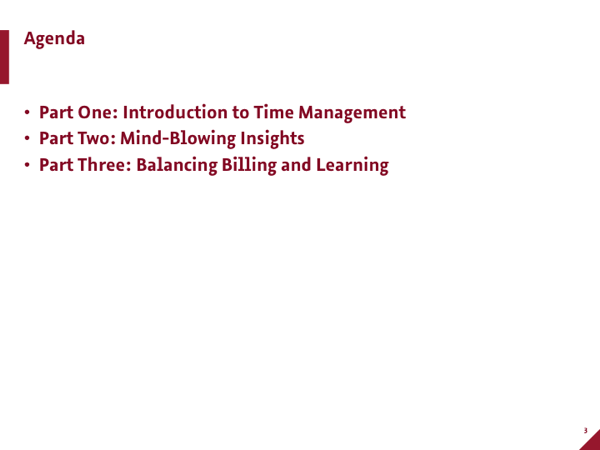
I have a few things to talk through. First is time management in general, I’ll talk through some common frameworks and tools you can use to stay on top of what can be the crushing delivery workload. Second, I’ll get into a few half-baked thoughts on sort of the philosophy that should lie underneath your system. Then I’ll talk about a specific case of managing time, balancing the demands of actual work with staying current and racking up certs.

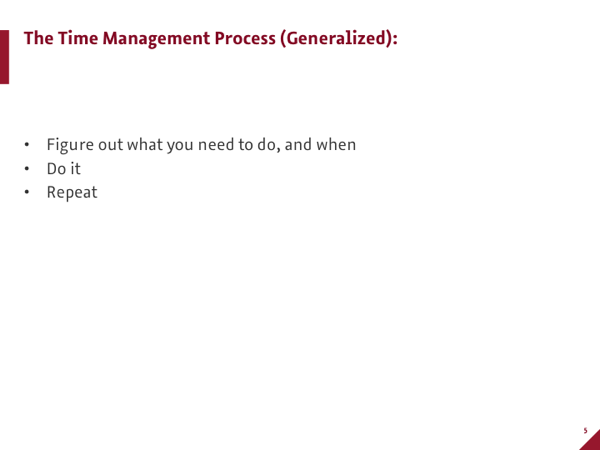
That’s really it. Thanks for your time.
Anything beyond this is, at least in part, navel-gazing and over-engineering. But we’re technical people, and that’s what we do, so we’ll dig deeper.
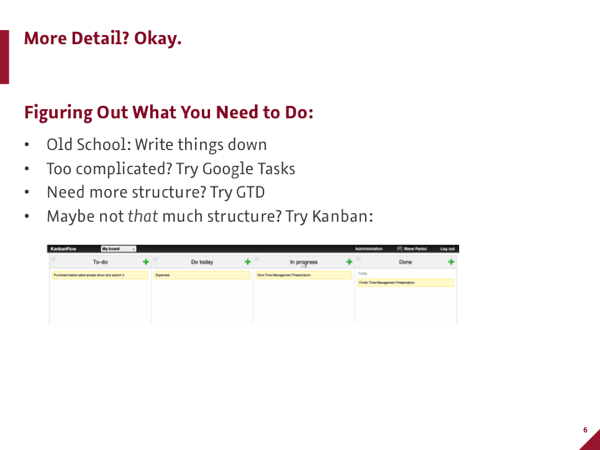
So that first part—figuring out what you need to do.
The trick is, gather and log everything. Where and how you log it is up to you.
There are all kinds of approaches to this. The traditional way is to just write stuff down, and cross it off as you do it. Every now and then I’ll be in a workshop and see somebody with an old-school Franklin-Covey planner, and that’s always refreshing. There’s a minimalist appeal to that, and if my hand writing were better and I knew I’d remember to carry the thing with me, I’d be drawn to that. A more modern spin on that would be just one or more text files that you store on some sort of cloud storage—iCloud, DropBox, whatever. Same idea. As you encounter things you need to do, log it so you don’t forget it.
If writing things down or maintaining text files sounds too clunky, you can use the Google Tasks feature built right into Gmail. Click Mail in the upper left corner, then drop down to Tasks to pop open a task tray. That’ll stay on top until you close it, so you can easily add to an ongoing list as you process e-mail.
If you want something a bit more structured, David Allen’s Getting Things Done system is popular. The idea is you build a system into which you capture everything that might require action on your part. Work stuff, home stuff, everything. New thoughts get captured into an Inbox. Then, whenever you can stop for air, you sort through that inbox. You apply a simple system of “Do it, delegate it, defer it, or drop it.” If it’s a bigger thing or part of a bigger thing, you convert it to a project and start building a list of subtasks. Each task has to be actionable—you don’t log it as “Time Management Presentation,” you do it as “Prepare Time Management Presentation,” or “Give Time Management Presentation.” Each task can have a start by or due by time associated with it, and you can generate views for what’s due to complete or start on what day. There’s another layer of metadata you can apply to each tasks called Context, which links the task to a location or situation. You could have contexts for at work, at home, on train, in bathroom—wherever you think you might be productive. As you do things, you check them complete, and you have a daily/weekly/monthly review of active and completed tasks to make sure you didn’t forget anything.
One big draw to this approach is that after you’ve gotten used to it, it becomes easier to maintain focus on any individual task. Not sure if you folks have the same problem I do, where if I’m trying to crank away at something, I’ll be sidelined by some random thought that just gnaws away at you, stealing focus from actual work. Maybe working on a deliverable, Blah-blah vSphere, Blah-blah UCS, “Hey, do they make peanut butter and jelly Hot Pockets?” Blah-blah storage, Blah-blah sizing “If they don’t they should. I should write a letter.” Blah-blah current state. “I bet I could make a prototype.” Blah blah TCO “I’d have to get some real Hot Pockets first so I could re-use the foil sheath.” And so on. With the GTD system, you’re training yourself to immediately file that thought away, to be reviewed at a more appropriate time, so you can get get back to the task at hand without worrying about it creeping back up.
GTD’s big on the concept of flow, the idea that your best work is going to happen when you’re crazy-focused, and distractions, be they mental or physical, pull you out of that state, and force you to waste time trying to get back there.
I like the idea of GTD, but in practice, I find it a little overbearing. The overhead of lists of lists and tracking what I’m going to do wherever I might be feels to me like a sort of micromanagement, and I’m not a fan of that. Particularly when the person micromanaging me is me—that guy’s a jerk.
GTD’s popularity has spawned a whole industry of companion task management applications, and you don’t need to buy into all the dogma to get value from them. OmniFocus and Things are big on the Mac side. Todoist is cross-platform and has great Gmail integration. There are a ton, and they all do about the same thing, so just look around and find one that feels right to you.
If you like the workflow approach to GTD, but think there might be too much structure there, look at the Personal Kanban approach. This came from old Lean Manufacturing and Process Improvement stuff, originally a way to track a batch of production from state to state as it moves through a process, using a Kanban board—a whiteboard, posterboard with post-its, or an app (Trello is the most popular one)—that tracks the stuff you have to do in one column, the stuff you want to do today in another column, the stuff you’re working on at the moment in a third, and stuff that’s done in a fourth. Like a funnel, you start with all the stuff you could possibly worry about on the far left, pick out a set to work on for the day, and narrow that down to a couple at a time. You’re free to adjust the number of columns and what they’re called to suit however you want to work. A central idea here is that you can only really be working on a couple of things at the same time, with one being most preferred. It’s very simple to start working with, and it gives that really easy sense of perspective—that you-are-here kind of idea—by just glancing at the board.
I just ran through a bunch of different tools you could use to collect and track things to do. If any sound appealing to you, I’d encourage you to give them a shot. Don’t worry about whether one is better than the other, just think of it in terms of which can work for you. Any approach here is better than no approach. The results are what matters, not the process.
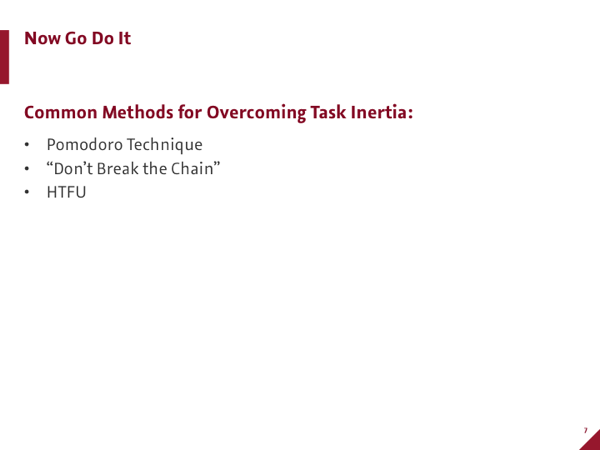
Let’s talk about the act of doing things.
There’s a cost associated with going from not-doing-something to doing-something, or doing-something to doing-something-else. There’s effort that needs to be expended. Going from full-stop to doing-something is particularly costly. I tend to refer to that as task inertia. An object—you—at rest wants to stay at rest. The cost of that shift into action is inversely proportional to how much you want to do it. More on that later.
So here are a couple of things to try to get you over that task inertia.
The first is the Pomodoro Technique. I’m told Pomodoro is italian for tomato, and the technique is named after a particular kind of kitchen timer, shaped like a tomato. The idea here is that you block out some time for yourself, and set your timer. Twenty-five minutes is as-prescribed, but you’re free to play around with it. For 25 minutes, you work. When the timer goes off, you stop. You go do something else, something not-work, for a short period of time. Just a breather. Then, you reset the timer and start again. After every few cycles, you take a longer break. Again, lots of room for experimentation here to find out what works best for you.
The timer can be a physical thing you put on your desk, or one of a million applications that have been created just for this. If you’re in an office environment, go with the actual timer. Put it somewhere visible, and train people to leave you the hell alone when the timer is out.
Proactively schedule Pomodoro windows, when you can. If you see you have a big open period in your calendar, block out an hour or two for this. This’ll prevent project managers from assuming you’re free and dropping last-second meeting requests. Well, it won’t stop them from doing it, but they’ll at least apologize for it.
Another neat technique is “Don’t Break the Chain.” This comes from noted productivity guru Jerry Seinfeld. The story goes that someone once asked him how he kept developing material while spending so much time on his TV show, and later, how he kept himself doing it when he had a billion dollars in the bank. He had a really simple system. He reasoned that to write good material, you need to write a lot of it. You may have heard of Malcolm Gladwell’s book Outliers, where he posits that you can be an expert in anything if you’re willing to spend 10,000 hours practicing. Same idea here. Seinfeld felt he had to spend some time, however much time he could, every day, writing. His technique was to get a wall calendar, the type that have the whole year on one big page, and put a big red X on each day he wrote, even if it was for just ten minutes. After a few days, he had a respectable chain of red Xs going, and he had built up some momentum. From then on, he just had to not break the chain. Devastatingly simple.
You can use this a couple different ways. Maybe to prepare for a longer-term certification, or maybe just to try to study something, anything, every day. Maybe you have an outside interest and you’re trying to foster some kind of work-life balance thing, use the chain for that. It helps if you can put the calendar up right near where you work, so it can sit there silently judging you all day, until you do whatever it is you want to do.
I would recommend one adjustment to this trick, though. If you miss a day, circle it, and keep going the next day. If you know you’re not going to be able to do it for a day or two ahead of time, draw a line through those days. That way, your chain stays in tact, visually. I would imagine it’s demoralizing to see the chain end, and that might prevent you from getting back into the swing of things.
A third option is to simply harden up, folks. Just do the work. A buddy of mine is in his 30s and just finishing school this year. He’s spent 15 years working through a combined Ph.D in neuroscience and MD program, and these days he’s dissecting rat brains by day and being elbow deep in gunshot wounds by night. I can never complain about work with him–a bad day at my job and a bad day at his are orders of magnitude apart.

While we talked through a bunch of things very broadly in part one, I want to come back to that very simple generalized process. Know what you have to do, do it, and repeat. Everything else is window dressing, or mental tricks to play on yourself.
Given that, if you think you have a time management problem, I would suggest that what you really have is a motivation problem. So:

Let me explain.
Things you legitimately want to do are much easier to get done. Things you’re not particularly interested in can languish, and eventually get you in trouble.
Combating this is a matter of alignment. You need to figure out what you want to be doing, and we need to get you doing that when possible. But it’s not going to happen every time. Not all the work is interesting to everyone, all the time.
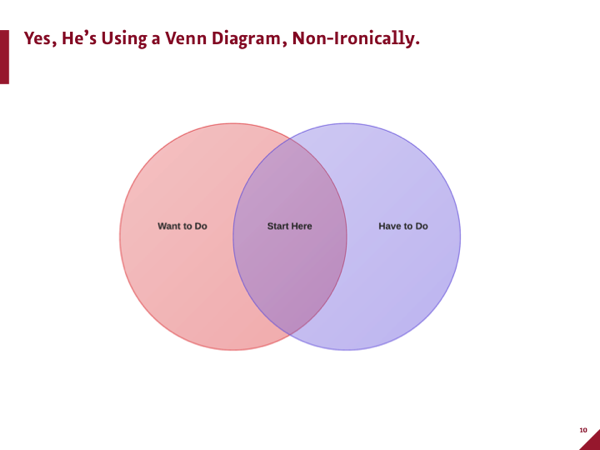
Assuming you’re using some sort of formal system as discussed earlier, you’re going to be capturing all the stuff you want to get done. Make sure you’re capturing everything, not just work stuff. If you’re just tracking work stuff, non-work stuff will quickly fall by the wayside and you’ll burn out. Now, not all of those tasks captured will share the same disposition. Some are things you’ll genuinely want to do–a new automation project, write the great American novel, invent PB&J hot pockets. Some are commitments you have to do, but aren’t all that thrilled with–VDI workshops, expenses, changing diapers.
There should be some overlap. Hopefully quite a bit. Some of the things you have to do will conveniently be things you want to do. These are going to be the easiest things to get done, because the drive is there. Where you can, start your day with those to generate momentum.
This leaves two piles of stuff. Things you want to do, that may not be related to actual billable work, and things that are but that you just don’t want to do. Try to find some balance there. Do something you don’t want to do, then reward yourself with something you do. Pomodoro your way through some thing that sucks, and rest with something that doesn’t.
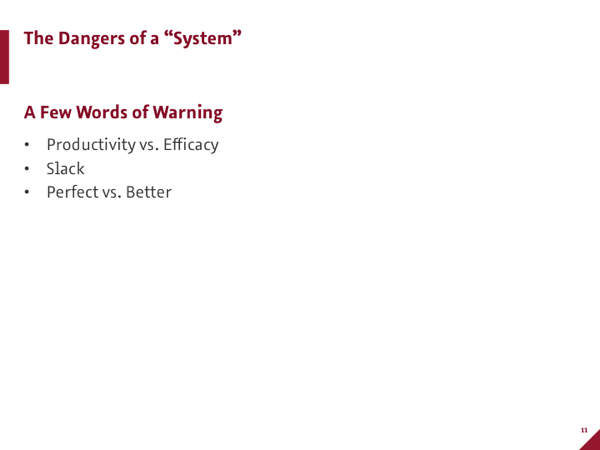
A word of caution about spending a bunch of time building out a system. You need to be careful that the system is supporting valuable work you’re doing, and not becoming an end unto itself. It’s easy to fall into a pattern of logging a task and checking it off, and calling that productivity. It can feed a sort of good-enough system that encourages the bare minimum of effort necessary to convince yourself a task is complete. You need to be much more concerned with efficacy, how well you’re doing things, than with productivity, as measured by how many items you think you’ve completed. Half-assed work tends to come back to haunt you, causing rework and wasted time.
Another trap people fall into is assuming they own their schedule. If you’ve got this well-manicured list of things you’re going to do today, you may try to go a step further and try to say you’ll do x at y time and so on. You may engage in additional madness and assume you can fill an eight-hour day this way. This may sound good on paper.
But, things happen throughout the day. You’ll get pulled into meetings, people will drive-by with things you weren’t prepared for, the phone will ring, and ring, and ring. Your best-laid plans will quickly get derailed, and you may start to feel overwhelmed in trying to catch up to the schedule you set. That’s no way to live.
Years ago, I worked at a law firm where we paid a very nice lady just a ton of money to come in and teach us all basic project management. One of her first questions to us was what we considered, for planning purposes, a full work day. Somebody important told her, “Well, let’s start with eight hours, but most people work more than that.” She laughed. She explained that in her experience, you could get three to five hours of planned work out of someone, on a given day. The rest is lost to office overhead, distractions, firedrills, heat. I’ve found that to be true as well. If you’re going to try to micro-manage your day, set the bar low. This leaves you with breathing room to respond to last-minute changes in direction.
If you find yourself with hours left in the day, hit up the Want list. Or, see if Road House is on. Enjoy it, is what I’m saying—it won’t happen often.
And finally, as I’ve mentioned, technical people tend to overthink and overengineer things. If you want to build a system but still don’t feel 100% sure where to start, don’t sweat it. Do whatever. It’s glib but it’s true—don’t let perfect get in the way of better. Perfect is hard, and it’s often out of date by the time you get there. Just start with something, and improve over time.

From time to time I hear people lamenting that while they’d love to go out and learn something new, they’re just too busy doing project work. Their utilization is just too high for anything more to be expected of them.
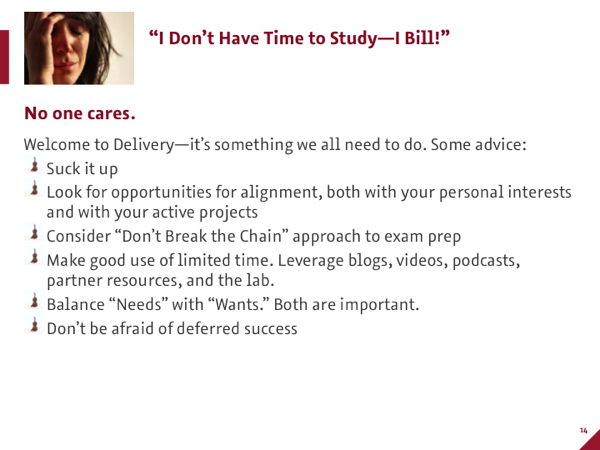
Learning is a need-to-do, but it also ought to be a want-to-do. If it’s not, you may need to ask yourself some tough questions.
Things move too fast in this business to get complacent. The value of your tricks decreases over time, you need to learn some new ones to stay relevant.
If you’re in a situation where you’re dedicated to a project and billing 40+ hours a week, well, staying current may mean working a little more. It sucks, I know. Ideally this doesn’t become the norm, but it’s very likely you’ll get gusts of that workload from time to time. It’s the nature of the work.
At the same time, just because you’re actively working a project doesn’t mean you can’t be learning at the same time. Look for opportunities for alignment there. Much of the work we do maps neatly into certification blueprints. If you hadn’t previously been interested in a particular certification or technology, maybe you look at your set of circumstances and re-evaluate. If you’re the virtualization person out on a Vblock deployment, spend some time with the storage person and learn a bit about VNX.
We talked about it earlier, but Don’t-Break-the-Chain is a good strategy for ongoing learning, even in the face of crippling billing targets. Just a little every day adds up over time.
Do the best you can with the time you have. There are a ton of resources out there on every subject. Books, blogs, videos, podcasts, partner eLearning, and our Lab. Figure out where you can fit these into your day.
There are going to be things we want you to get, and things you want to get. Again, when they overlap it’s easy, but they won’t always. Aside from the more popular certifications, we need to have a certain number of people with specific vendor specialist certifications. At times, you’re going to be asked to spend otherwise useful time on these largely-bullshit requirements, and it’s no fun. Treat this like any other Want/Need scenario. Try to reward yourself with something that fits your interest after you’ve sunk time on requirements.
And finally, don’t get hung up on testing. Some people worry themselves into paralysis in an exam room. You’re going to bomb the occasional test. Anyone that hasn’t, hasn’t taken enough of them. I’ve bombed plenty. It’s not a reflection of your character.

